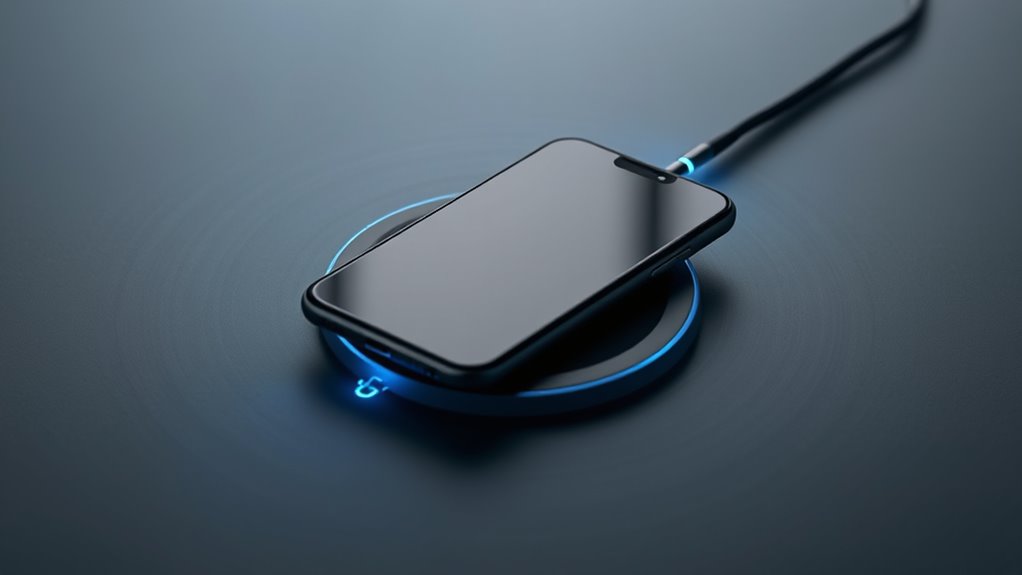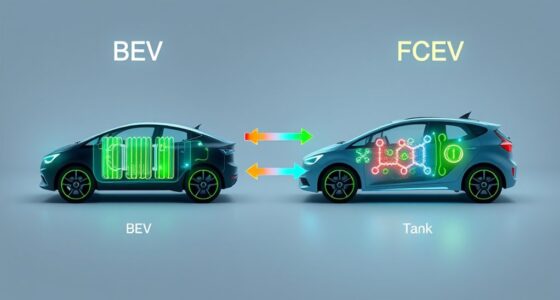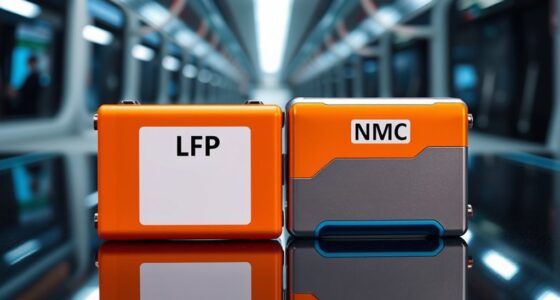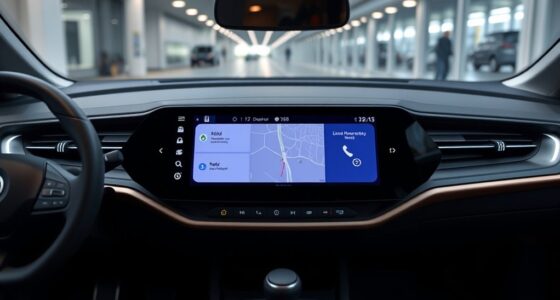Wireless charging pads transfer power using inductive coupling, which involves magnetic fields generated by coils in both the pad and your device. When aligned, these coils create an alternating magnetic field that transfers energy efficiently. Proper alignment and proximity are essential for maximum charging, as misalignment weakens magnetic coupling and reduces power transfer. Advanced techniques like resonant inductive coupling allow for more flexible placement while maintaining efficiency. To understand how all these components work together, keep exploring further.
Key Takeaways
- Wireless charging pads use inductive coupling with coils to transfer magnetic energy between the pad and device.
- Proper coil alignment and proximity are crucial for efficient power transfer and optimal charging speed.
- Resonant inductive coupling tunes coils to the same frequency, allowing effective energy transfer over greater distances.
- Magnetic fields induce electrical current in the device’s coil, converting magnetic energy into usable electrical power.
- Higher transfer efficiency reduces heat, improves safety, and ensures faster, more reliable wireless charging.
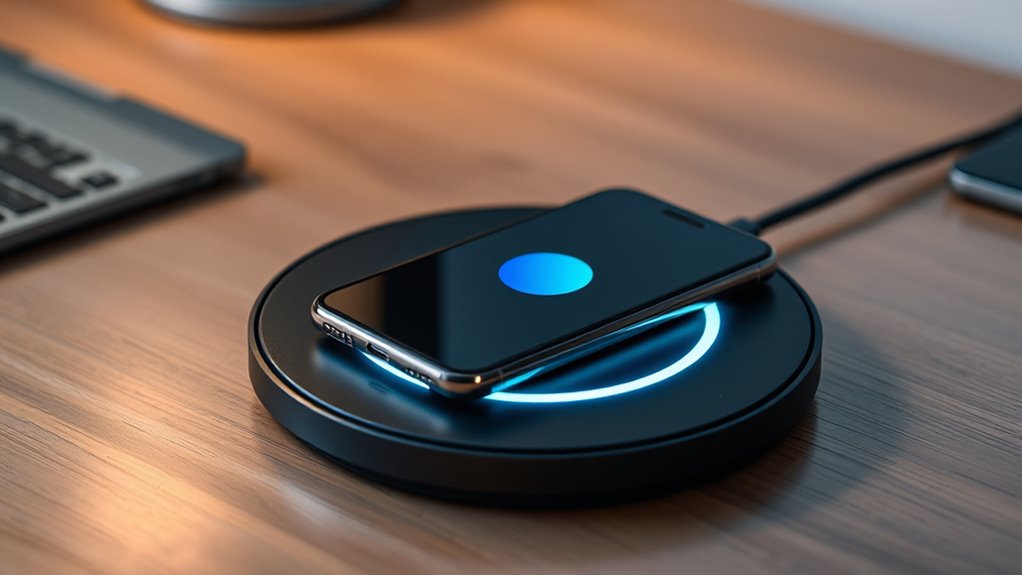
Wireless charging pads have revolutionized how you power your devices by transferring energy seamlessly without the need for cables. At the core of this technology is inductive coupling, a method that uses magnetic fields to transfer power efficiently between a charging pad and your device. When you place your compatible device on the pad, a coil inside the pad creates an alternating magnetic field. Your device contains a corresponding coil that captures this magnetic energy, converting it back into electrical power to charge the battery. This process relies heavily on precise alignment and the quality of the coils involved, which directly influence the power transfer efficiency. Ongoing research into AI security helps ensure that wireless charging systems remain safe from malicious interference, safeguarding your devices during the charging process. The principle of inductive coupling ensures that energy transfer occurs only when the coils are within close proximity and properly aligned. This proximity requirement is why wireless chargers often advise placing devices at the center of the pad. If the coils aren’t aligned properly, or if they’re too far apart, the magnetic coupling weakens, leading to reduced power transfer efficiency. This inefficiency manifests as slower charging speeds or, in some cases, the charger failing to detect your device altogether. Manufacturers continuously improve coil design and alignment mechanisms to maximize efficiency, ensuring your device charges as quickly and reliably as possible.
Wireless charging relies on inductive coupling, where magnetic fields transfer energy between aligned coils for efficient device charging.
Power transfer efficiency is a critical factor in wireless charging technology. It describes how well the energy from the charger makes it into your device’s battery. High efficiency means less energy lost as heat, which is safer and more energy-conscious. To optimize this, many wireless chargers incorporate features like resonant inductive coupling, which allows for a slightly greater distance between the charger and device while maintaining good efficiency. This technique involves tuning the coils to resonate at the same frequency, boosting energy transfer even when the coils aren’t perfectly aligned. As a result, your device can charge more flexibly without sacrificing speed or safety.
The efficiency of power transfer isn’t just about convenience; it also impacts the longevity of your devices and the safety of the charging process. Higher efficiency reduces heat buildup, which can degrade batteries over time. It also ensures that your device isn’t drawing excessive current, which could cause damage or reduce overall lifespan. As technology advances, improved coil materials, smarter circuit designs, and better tuning methods continue to enhance power transfer efficiency. This progress means you can expect faster, safer wireless charging experiences that are almost as reliable as traditional wired methods but without the clutter of cords.
Frequently Asked Questions
How Does Wireless Charging Work Through Cases or Covers?
You can usually charge your device through cases or covers, but metal interference and case materials matter. Wireless charging works best with cases made of plastic, silicone, or rubber, which don’t block signals. Metal or thick cases can disrupt power transfer, causing slow charging or no charge at all. To guarantee proper charging, remove metal accessories or use thinner, non-metallic cases.
Can Wireless Charging Damage My Device’s Battery Over Time?
Wireless charging usually doesn’t damage your device’s battery if you use a compatible charger. However, frequent wireless charging can accelerate battery degradation over time, especially if you often drain your battery completely or charge it repeatedly through many cycles. To extend your battery’s lifespan, avoid leaving it on the wireless pad constantly, and try to keep the charge level between 20% and 80%. This helps minimize the impact of charging cycles on your battery.
What Are the Safety Standards for Wireless Charging Pads?
A stitch in time saves nine, and safety standards for wireless charging pads guarantee you’re protected. You should look for devices with proper manufacturing certifications like FCC and UL, which guarantee compliance. These standards minimize risks from electromagnetic interference, preventing potential harm or device malfunction. Always buy certified products to ensure your wireless charger meets safety regulations, so you can enjoy seamless charging without worry.
How Does Alignment Affect Charging Efficiency?
You’ll see that proper magnetic alignment is vital for efficient wireless charging. When your device is correctly aligned with the charging pad, inductive coupling works best, transferring power more effectively. Misalignment weakens the magnetic connection, reducing charging speed and efficiency. To get the best results, make certain your device’s receiver coil aligns with the pad’s transmitter coil, maximizing inductive coupling and guaranteeing faster, more reliable charging.
Are There Differences in Charging Speeds Between Pads?
Yes, you’ll notice charging speed variations between different pads. Higher quality pads often deliver faster charging due to better coil design and power management. Cheaper pads might charge more slowly or inconsistently. Your device’s compatibility also plays a role, but overall, investing in a good-quality charging pad guarantees you get the fastest, most reliable charging speeds possible, making your charging experience more efficient and convenient.
Conclusion
Now that you understand how wireless charging pads transfer power, you might worry about safety or efficiency. Rest assured, these pads use safe electromagnetic fields that only transfer power when your device is properly aligned. Even if you’re in a busy space, the system automatically manages power transfer, so you don’t have to worry about overheating or interference. Embracing wireless charging means you’ll enjoy the convenience without sacrificing safety or performance.
